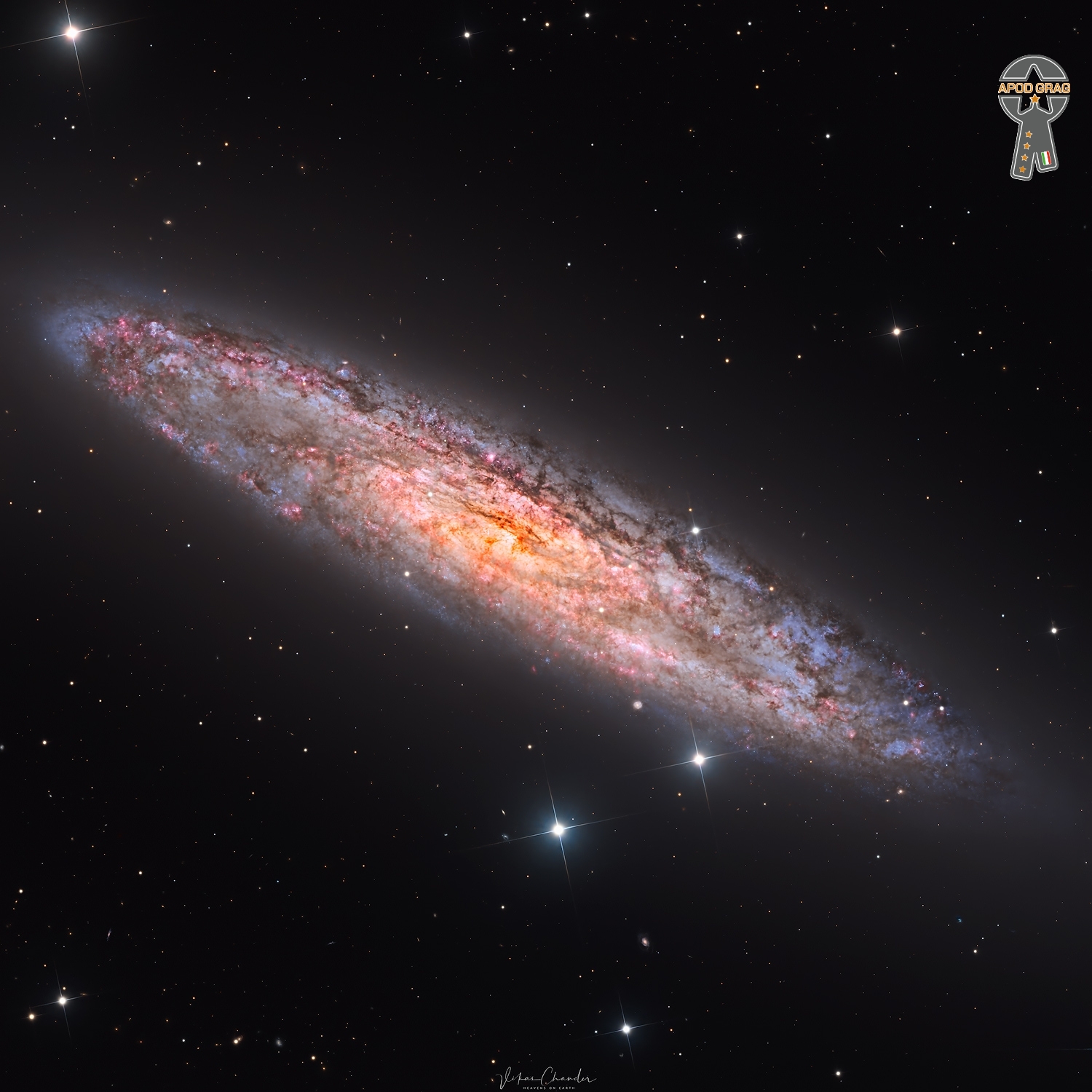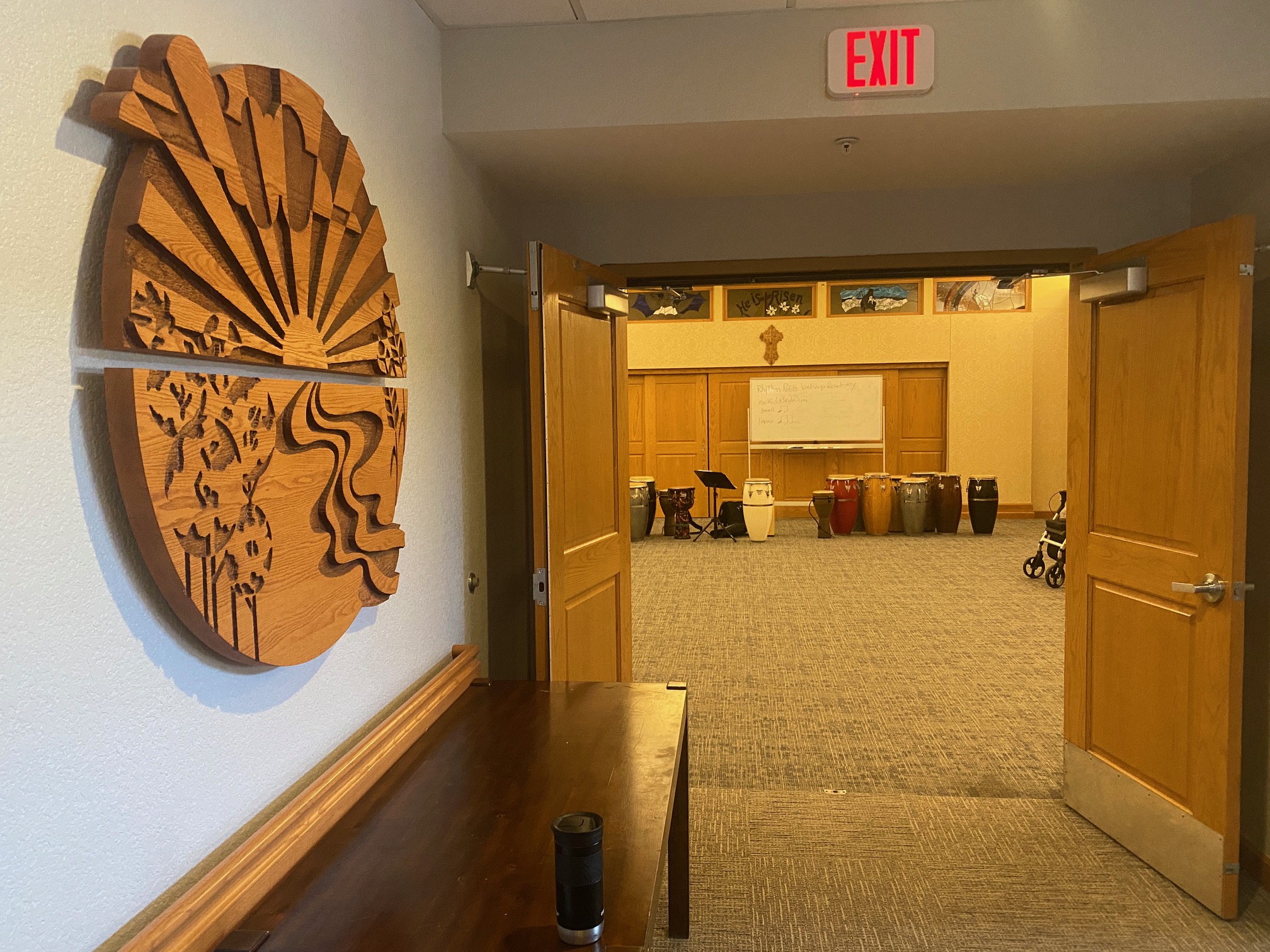Blog

Trumpler 16 is an open star cluster within the Carina Nebula (NGC 3372 or the Eta Carinae Nebula), located about 7,500 light-years away from Earth in the southern constellation of Carina (the Keel). It is slowly moving toward us at roughly 25 kilometers per hour.
This young cluster contains over 560 stars, including a significant population of very young stars, and three of the biggest and most impressive stars from our galaxy: Eta Carinae (not visible in this image), WR 25 and Tr16-244. Although intermediate-mass stars have been forming continuously over the last 10 million years, the high-mass stars formed within the last 3 million years.
What seems to be a single bright star might actually turn out to be several stars close together. Eta Carinae, with a mass of 100 to 150 times the mass of our Sun, probably coexists in a binary state with another massive supergiant; WR 25, the brightest object in the above image, consists of at least two separate stars of which the brightest star appears to be about 50 times the mass of our Sun. Additionally, Tr16 -244 (the third brightest, just to the upper left of WR 25) consists of at least three individual stars. The second brightest in this image, to the left of WR 25, is a low-mass star located much closer to Earth than the Carina Nebula.

Mahmoud Ahmed (Amharic: ማሕሙድ አሕመድ; born 8 May 1941) is an Ethiopian singer. He gained great popularity in Ethiopia in the 1970s and among the Ethiopian diaspora in the 1980s, before rising to international fame with African music fans in Europe and the Americas.
Born in Addis Ababa, Mercato district, Mahmoud was enthralled with the music he heard on Ethiopian radio from an early age. Having poorly learned in school, he worked as a shoeshiner before becoming a handyman at the Arizona Club, which was the after hours hangout of Emperor Haile Selassie I‘s Imperial Bodyguard Band. One night in 1962 when the band’s singer didn’t show up, Mahmoud asked to sing a few songs. He soon became part of the band’s regular lineup, where he remained until 1974.
more...Keith Jarrett (born May 8, 1945) is an American pianist and composer. Jarrett started his career with Art Blakey and later moved on to play with Charles Lloyd and Miles Davis. Since the early 1970s, he has also been a group leader and solo performer in jazz, jazz fusion, and classical music. His improvisations draw from the traditions of jazz and other genres, including Western classical music, gospel, blues, and ethnic folk music.
His album, The Köln Concert, released in 1975, is the best-selling piano recording in history. In 2008, he was inducted into the Down Beat Jazz Hall of Fame in the magazine’s 73rd Annual Readers’ Poll.
In 2003, Jarrett received the Polar Music Prize and was the first recipient to be recognized with prizes for both contemporary and classical music. In 2004, he received the Léonie Sonning Music Prize.
In February 2018, Jarrett suffered a stroke and has been unable to perform since. A second stroke in May 2018 left him partially paralyzed and unable to play with his left hand.
Jarrett was born on May 8, 1945, in Allentown, Pennsylvania, to a mother of Slovenian descent. Jarrett’s grandmother was born in Segovci, near Apače in Slovenia. Jarrett’s father was of mostly Germandescent. He grew up in suburban Allentown with significant early exposure to music.
more...Mary Lou Williams (born Mary Elfrieda Scruggs; May 8, 1910 – May 28, 1981) was an American jazzpianist, arranger, and composer. She wrote hundreds of compositions and arrangements and recorded more than one hundred records (in 78, 45, and LP versions). Williams wrote and arranged for Duke Ellington and Benny Goodman, and she was friend, mentor, and teacher to Thelonious Monk, Charlie Parker, Miles Davis, Tadd Dameron, Bud Powell, and Dizzy Gillespie.
She has been noted for her 1954 conversion to Catholicism, which led to a musical hiatus and a later transformation in the nature of her music. She continued to perform and work as a philanthropist, educator, and youth mentor until her death from bladder cancer in 1981.
In 1927, Williams married saxophonist John Overton Williams. She met him at a performance in Cleveland where he was leading his group, the Syncopators, and moved with him to Memphis, Tennessee. He assembled a band in Memphis, which included Williams on piano. In 1929, 19-year-old Williams assumed leadership of the Memphis band when her husband accepted an invitation to join Andy Kirk‘s band in Oklahoma City. Williams joined her husband in Oklahoma City but did not play with the band. The group, Andy Kirk’s Twelve Clouds of Joy, moved to Tulsa, Oklahoma, where Williams, when she wasn’t working as a musician, was employed transporting bodies for an undertaker. When the Clouds of Joy accepted a longstanding engagement in Kansas City, Missouri, Williams joined her husband and began sitting in with the band, as well as serving as its arranger and composer. She provided Kirk with such songs as “Froggy Bottom”, “Walkin’ and Swingin'”, “Little Joe from Chicago”, “Roll ‘Em”, and “Mary’s Idea”.
Williams was the arranger and pianist for recordings in Kansas City (1929) Chicago (1930), and New York City (1930). During a trip to Chicago, she recorded “Drag ‘Em” and “Night Life” as piano solos. She used the name “Mary Lou” at the suggestion of Jack Kapp at Brunswick Records. The records sold quickly, raising Williams to national prominence. Soon after the recording session she became Kirk’s permanent second pianist, playing solo gigs and working as a freelance arranger for Earl Hines, Benny Goodman, and Tommy Dorsey. In 1937, she produced In the Groove (Brunswick), a collaboration with Dick Wilson, and Benny Goodman asked her to write a blues song for his band. The result was “Roll ‘Em”, a boogie-woogie piece based on the blues, which followed her successful “Camel Hop”, named for Goodman’s radio show sponsor, Camel cigarettes. Goodman tried to put Williams under contract to write for him exclusively, but she refused, preferring to freelance instead.
more...Robert Leroy Johnson (May 8, 1911 – August 16, 1938) was an American blues musician and songwriter. His landmark recordings in 1936 and 1937 display a combination of singing, guitar skills, and songwriting talent that has influenced later generations of musicians. Although his recording career spanned only seven months, he is recognized as a master of the blues, particularly the Delta blues style, and as one of the most influential musicians of the 20th century. The Rock and Roll Hall of Fame describes him as perhaps “the first ever rock star”.
As a traveling performer who played mostly on street corners, in juke joints, and at Saturday night dances, Johnson had little commercial success or public recognition in his lifetime. He participated in only two recording sessions, one in San Antonio in 1936, and one in Dallas in 1937, that produced 29 distinct songs (with 13 surviving alternate takes) recorded by Don Law. These songs, recorded solo in improvised studios, were the totality of his recorded output. Most were released as 10-inch, 78 rpm singles from 1937–1938, with a few released after his death. Other than these recordings, very little was known of his life outside of the small musical circuit in the Mississippi Delta where he spent most of his time. Much of his story has been reconstructed by researchers. Johnson’s poorly documented life and death have given rise to legends. The one most often associated with him is that he sold his soul to the devil at a local crossroads in return for musical success.
His music had a small, but influential, following during his life and in the two decades after his death. In late 1938 John Hammond sought him out for a concert at Carnegie Hall, From Spirituals to Swing, only to discover that Johnson had died. Brunswick Records, which owned the original recordings, was bought by Columbia Records, where Hammond was employed. Musicologist Alan Lomax went to Mississippi in 1941 to record Johnson, also not knowing of his death. Law, who by then worked for Columbia Records, assembled a collection of Johnson’s recordings titled King of the Delta Blues Singers that was released by Columbia in 1961. It is credited with finally bringing Johnson’s work to a wider audience. The album would become influential, especially in the nascent British blues movement; Eric Clapton has called Johnson “the most important blues singer that ever lived.” Bob Dylan, Keith Richards, and Robert Plant have cited both Johnson’s lyrics and musicianship as key influences on their own work. Many of Johnson’s songs have been covered over the years, becoming hits for other artists, and his guitar licks and lyrics have been borrowed by many later musicians.
Renewed interest in Johnson’s work and life led to a burst of scholarship starting in the 1960s. Much of what is known about him was reconstructed by researchers such as Gayle Dean Wardlow and Bruce Conforth, especially in their 2019 award-winning biography of Johnson: Up Jumped the Devil: The Real Life of Robert Johnson (Chicago Review Press). Two films, the 1991 documentary The Search for Robert Johnson by John Hammond Jr., and a 1997 documentary, Can’t You Hear the Wind Howl?: The Life & Music of Robert Johnson, which included reconstructed scenes with Keb’ Mo’ as Johnson, were attempts to document his life, and demonstrated the difficulties arising from the scant historical record and conflicting oral accounts. Over the years, the significance of Johnson and his music has been recognized by the Rock and Roll, Grammy, and Blues Halls of Fame, and by the National Recording Preservation Board. Johnson died on August 16, 1938, at the age of 27, near Greenwood, Mississippi, of unknown causes. Johnson’s death was not reported publicly. Almost 30 years later, Gayle Dean Wardlow, a Mississippi-based musicologist researching Johnson’s life, found Johnson’s death certificate, which listed only the date and location, with no official cause of death. No formal autopsy had been done. Instead, a pro forma examination was done to file the death certificate, and no immediate cause of death was determined. It is likely he had congenital syphilis and it was suspected later by medical professionals that this may have been a contributing factor in his death. However, 30 years of local oral tradition had, like the rest of his life story, built a legend which has filled in gaps in the scant historical record.
more...The Sculptor Galaxy (also known as the Silver Coin Galaxy, Silver Dollar Galaxy, NGC 253, or Caldwell 65) is an intermediate spiral galaxy in the constellation Sculptor. The Sculptor Galaxy is a starburst galaxy, which means that it is currently undergoing a period of intense star formation.
The galaxy was discovered by Caroline Herschel in 1783 during one of her systematic cometsearches. About half a century later, John Herschel observed it using his 18-inch metallic mirror reflector at the Cape of Good Hope. He wrote: “very bright and large (24′ in length); a superb object…. Its light is somewhat streaky, but I see no stars in it except 4 large and one very small one, and these seem not to belong to it, there being many near..

William Kreutzmann Jr. born May 7, 1946) is an American drummer and founding member of the rock band Grateful Dead. He played with the band for its entire thirty-year career, usually alongside fellow drummer Mickey Hart, and has continued to perform with former members of the Grateful Dead in various lineups, and with his own bands BK3, 7 Walkers and Billy & the Kids.
Kreutzmann was born in Palo Alto, California, the son of Janice Beryl (née Shaughnessy) and William Kreutzmann Sr. His father was of German descent. His maternal grandfather was football coach and innovator Clark Shaughnessy.
Kreutzmann started playing drums at the age of 13. At first he practiced on a Slingerland drum kit lent to him. As a teenager, he was practicing drums alone in a large building at his high school when Aldous Huxley and another man walked in. Huxley told Bill he’d never heard anything like it, and encouraged him in his drumming – despite the fact Bill had been told by his sixth grade music teacher that he could not keep a beat. Kreutzmann continued to practice a great deal. His earliest enthusiasm was for the music of Ray Charles and other R&B musicians. He has explained that later he learned some advanced technique or tricks from Mickey Hart.
Kreutzmann listened to jazz groups in clubs when he found an opportunity for an under-age guy to get in. After joining the Warlocks (later called the Grateful Dead), bassist Phil Lesh introduced him the work of one of the top jazz drummers of the time, Elvin Jones. Kreutzmann became an enthusiast, also, for the funkmusic of The Meters.
more...Jimmy Lee Ruffin (May 7, 1936 – November 17, 2014) was an American soul singer, and the older brother of David Ruffin, the lead singer of the Temptations. He had several hit records between the 1960s and 1980s, the most successful being the Top 10 hits “What Becomes of the Brokenhearted” and “Hold On (To My Love)“.
Jimmy Ruffin was born in 1936 in Collinsville, Mississippi, to Eli, a sharecropper, and Ophelia Ruffin. He was approaching his fifth birthday when his younger brother David was born. As children, the brothers began singing with a gospel group, the Dixie Nightingales.
In 1961, Jimmy became a singer as part of the Motown stable, mostly on sessions but also recording singles for its subsidiary Miracle label, but was then drafted for national service. After leaving the Army in 1964, he returned to Motown, where he was offered the opportunity to join the Temptations to replace Elbridge Bryant. However, after hearing his brother David, they hired him for the job instead so Jimmy decided to resume his solo career. Ruffin recorded for Motown’s subsidiary Soul label, but with little success.
more...Nexhmije Pagarusha (Albanian pronunciation: [neˈd͡ʒmijɛ pagaˈɾuʃa]; 7 May 1933 – 7 February 2020) was a Kosovo-Albanian singer and actress, often referred to as the Queen of Albanian music. Pagarusha gained acclaim as a recording artist in Kosova and neighbouring countries for her distinct soprano vocal range, which she displayed performing various Kosovan folk songs during her career, which spanned 36 years, from 1948, in her debut in Radio Prishtina, to 1984, in her final concert in Sarajevo. Her music style was not limited just to Albanian music, as she performed rock, pop, funk, opera/classical, and many more.
more...Johannes Brahms ; 7 May 1833 – 3 April 1897) was a German composer, pianist, and conductor of the mid-Romantic period. Born in Hamburg into a Lutheran family, he spent much of his professional life in Vienna. He is sometimes grouped with Johann Sebastian Bach and Ludwig van Beethoven as one of the “Three Bs” of music, a comment originally made by the nineteenth-century conductor Hans von Bülow.
Brahms composed for symphony orchestra, chamber ensembles, piano, organ, voice, and chorus. A virtuoso pianist, he premiered many of his own works. He worked with leading performers of his time, including the pianist Clara Schumann and the violinist Joseph Joachim (the three were close friends). Many of his works have become staples of the modern concert repertoire.
Brahms has been considered both a traditionalist and an innovator, by his contemporaries and by later writers. His music is rooted in the structures and compositional techniques of the Classical masters. Embedded within those structures are deeply Romantic motifs. While some contemporaries found his music to be overly academic, his contribution and craftsmanship were admired by subsequent figures as diverse as Arnold Schoenberg and Edward Elgar. The detailed construction of Brahms’s works was a starting point and an inspiration for a generation of composers.
more...Pyotr Ilyich Tchaikovsky (/tʃaɪˈkɒfski/ chy-KOF-skee; 7 May 1840 – 6 November 1893) was a Russian composer of the Romantic period. He was the first Russian composer whose music would make a lasting impression internationally. Tchaikovsky wrote some of the most popular concert and theatrical music in the current classical repertoire, including the ballets Swan Lake and The Nutcracker, the 1812 Overture, his First Piano Concerto, Violin Concerto, the Romeo and Juliet Overture-Fantasy, several symphonies, and the opera Eugene Onegin.
Although musically precocious, Tchaikovsky was educated for a career as a civil servant as there was little opportunity for a musical career in Russia at the time and no system of public music education. When an opportunity for such an education arose, he entered the nascent Saint Petersburg Conservatory, from which he graduated in 1865. The formal Western-oriented teaching that Tchaikovsky received there set him apart from composers of the contemporary nationalist movement embodied by the Russian composers of The Five with whom his professional relationship was mixed.
Tchaikovsky’s training set him on a path to reconcile what he had learned with the native musical practices to which he had been exposed from childhood. From that reconciliation, he forged a personal but unmistakably Russian style. The principles that governed melody, harmony, and other fundamentals of Russian music diverged from those that governed Western European music, which seemed to defeat the potential for using Russian music in large-scale Western composition or for forming a composite style, and it caused personal antipathies that dented Tchaikovsky’s self-confidence. Russian culture exhibited a split personality, with its native and adopted elements having drifted apart increasingly since the time of Peter the Great. That resulted in uncertainty among the intelligentsia about the country’s national identity, an ambiguity mirrored in Tchaikovsky’s career.
Despite his many popular successes, Tchaikovsky’s life was punctuated by personal crises and depression. Contributory factors included his early separation from his mother for boarding school followed by his mother’s early death, the death of his close friend and colleague Nikolai Rubinstein, his failed marriage with Antonina Miliukova, and the collapse of his 13-year association with the wealthy patroness Nadezhda von Meck. Tchaikovsky’s homosexuality, which he kept private, has traditionally also been considered a major factor though some scholars have played down its importance. His dedication of his Sixth symphony to his nephew Vladimir “Bob” Davydov and his feelings expressed about Davydov in letters to others, especially following Davydov’s suicide, have been cited as evidence for a romantic love between the two. Tchaikovsky’s sudden death at the age of 53 is generally ascribed to cholera, but there is an ongoing debate as to whether cholera was indeed the cause and whether the death was accidental or intentional.
While his music has remained popular among audiences, critical opinions were initially mixed. Some Russians did not feel it was sufficiently representative of native musical values and expressed suspicion that Europeans accepted the music for its Western elements. In an apparent reinforcement of the latter claim, some Europeans lauded Tchaikovsky for offering music more substantive than exoticism, and said he transcended the stereotypes of Russian classical music. Others dismissed Tchaikovsky’s music as deficient because it did not stringently follow Western principles.
more...
The celestial object showcased in this week’s Hubble Picture of the Week is the spiral galaxy UGC 9684, which lies around 240 million light-years from Earth in the constellation Boötes. This image shows an impressive example of several classic galactic features, including a clear bar in the galaxy’s centre, and a halo surrounding its disc.
The impetus for this Hubble image was a study into the host galaxies of Type-II supernovae. These cataclysmic stellar explosions take place throughout the Universe, and are of great interest to astronomers, so automated surveys scan the night sky and attempt to catch sight of them. The supernova which brought UGC 9684 to Hubble’s attention occurred during 2020. It has faded from view in this image, which was taken in 2023.
Remarkably, the 2020 supernova in this galaxy isn’t the only one that’s been seen there — four supernova-like events have been spotted in UGC 9684 since 2006, putting it up there with the most active supernova-producing galaxies. It turns out that UGC 9684 is a quite active star-forming galaxy, calculated as producing one solar mass worth of stars every few years! This level of stellar formation makes UGC 9684 a veritable supernova factory, and a galaxy to watch for astronomers hoping to examine these exceptional events.
[Image Description: A spiral galaxy in the centre of a dark background, surrounded by a few distant galaxies and nearby stars. The galaxy is tilted diagonally and partially towards the viewer. Its disc is cloudy and threaded with dust, without clear arms. A bar of light extends across the disc from the glowing core. A faint halo of gas surrounds the disc.]

More Posts
- Farid al-Atrash
- Vinicius de Moraes
- World Music with Transglobal Underground
- Daily Roots with Leroy Smart
- Republican Accountability Project
- Racism 1957 to 2021
- The Cozmos with Arp 86
- Esperanza Spalding
- Winton Marsalis
- Chuck Berry
- Ambrose Thibodeaux
- World Music with Ogún Afrobeat
- Daily Roots with Don Carlos
- The Cozmos with M33
- Ziggy Marley
- Rico Rodriguez
- Barney Kessel
- Cozy Cole
- World Music with Kadialy Kouyaté
- Daily Roots with John Holt